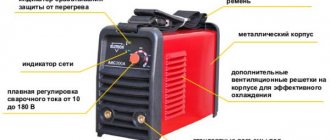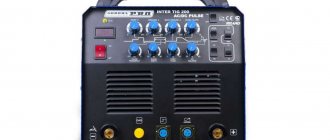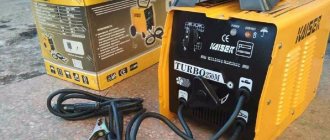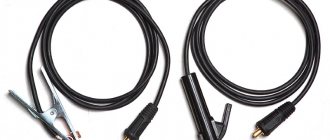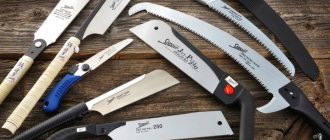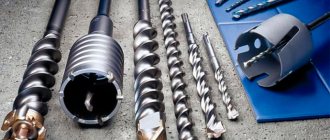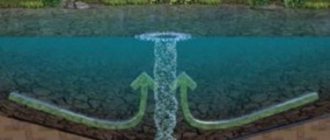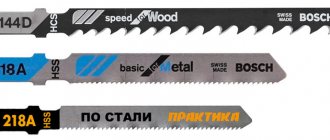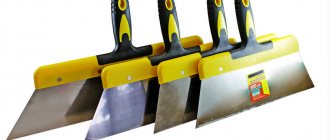Protect your eyes | 02/23/2016
Welding, as a type of joining metal elements, became widespread a little more than a century ago. However, today it is used in many fields of activity, from electronics production to the construction of giant structures. Since the composition of the metals used is very diverse, many types of equipment have been invented and implemented to obtain reliable welds. The most popular among them are welding machines. Let's look at what types of welding machines there are, the pros and cons of each.
Transformers
The transformer is the most traditional type of electric welding machine. At the same time, it is one of the simplest in design. The main design element of this type of welder is a step-down transformer, which converts the mains voltage to the value required for welding. The current strength is changed using different techniques, the most well-known is the displacement of one winding relative to the second. As the gap between the windings changes, the current changes.
A feature of welding transformers is considered to be alternating current at the output, which leads to noticeable spattering of metal and deterioration in the quality of seams. In order to weld non-ferrous metals and improve the quality of arc combustion, fairly massive and bulky components must be added to the structure of the apparatus. The main element - the transformer - is also not compact and light in weight. When using the device for serious work, specific (for alternating current) electrodes and considerable experience of the welder are required.
The efficiency of the device is quite high, reaching 90%, but part of the energy is spent on heating. Cooling is carried out using fans of different power, since it is necessary to cool a unit weighing several tens and sometimes hundreds of kilograms. The use of this type of welding machines is declining today, but they are still in demand due to their low cost, reliability and durability. Transformers are used for welding low-alloy types of steel .
Main characteristics of inverter devices
You need to be well versed in these characteristics. They will help you both in working with the inverter and in choosing a device when purchasing it, taking into account your experience, work plans and the thickness of your wallet.
Inverter characteristics.
The parameters for an inverter type welding machine are as follows:
- Mains voltage from a standard electrical network on which the inverter can operate. Usually these are two values: 380V and 220V. For the home, choose devices that operate with a voltage of 220V.
- The type of current produced at the inverter output.
- Current parameters at start. The quality and specifications of the electrodes depend on these values. More precisely, the diameter of the electrodes.
- The power of the device, on which the strength of the welding current at the output for the welding arc will depend.
- The ease of ignition of the welding arc, which depends on the open circuit voltage.
- Electrode diameters that should be used on a specific inverter.
- The lower and upper levels of the current received at the output of the device.
- Dimensions of the device - dimensions and weight. Remember the rule: the smaller the dimensions, the lower the power of the device, the lower the output current will be. If you are interested in an inverter with wide functionality, remove the “compactness” criterion from among the very first ones.
Inverters are very modern devices. They have a number of special options that are designed to make the welder's work easier. And ease of use always leads to improved quality of the final product, which in our case is a welding seam.
It is these new functions that make highly complex welding possible for people without much professional experience.
- “Hot start” is the supply of an additional electrical charge to the electrode, which greatly facilitates the ignition of the welding arc.
- “Anti-stick” is the most important function, especially for beginners in welding. At the slightest sign of sticking of the electrode, the current supply to it is automatically reduced.
- “Arc force” is the automatic supply of a higher current if the electrode end is in undesirable proximity to the surfaces of the metal workpieces being welded.
Rectifiers
Welding rectifiers can be considered an improvement on transformer devices. In welds obtained using rectifiers, those defects that are caused by the use of alternating current are practically eliminated. The devices, in addition to the step-down transformer, have a diode block (rectifier), control, starting and protection elements in their design. Alternating current not only changes voltage, but is also converted to direct current. This makes it possible to obtain an even, stable arc. Accordingly, metal spattering is reduced, and the seam is of higher quality. You can work with any electrodes.
The scope of use of the welder is also expanding - you can join not only low-alloy “ferrous” steels, but also non-ferrous metals, stainless steel, cast iron (using appropriate electrodes). Since direct current has polarity, you should not forget about this - when connecting the electrodes, this parameter should be taken into account. Some welding work is purposefully performed with reverse polarity (aluminium welding).
Many manufacturers today are reducing the production of this type of household appliances. If we talk about professional use, they are still used quite widely . Disadvantages include heavy weight, the need for a qualified welder, and a serious voltage drop in the electrical network during the welding process. Advantages: low price, reliability and good seam quality.
How to choose a welding machine for your home
Versatility, compactness, light weight, ease of use, inexpensive price - this is the kind of welding machine you want to have at home as your own unit. Most buyers of home welding machines opt for inverter models.
This fact does not mean at all that transformers or rectifiers have stopped being purchased. And there are reasons for this. Let's figure out which welding machine is best for you “here and now”. The types of welding equipment are extremely diverse, so we make a choice taking into account all personal needs.
Choosing a home transformer:
- The most important thing you need to pay attention to when choosing a welding transformer for home work is the operating voltage of the step-down transformer. They are able to operate from a network with two characteristics: either three-phase or single-phase with values of 380/220V. There are universal use models that can connect to any type of network: 220V, three-phase network, phase voltage between two phases.
- The next most important parameter is the power of the transformer. In this regard, devices operating from a network with a voltage of 380V are optimal; they are much more powerful and almost do not cause voltage imbalances in the network. But not all consumers of home welding machines have the ability to connect to a three-phase network. It should be remembered that the power of the transformer cannot be higher than the maximum permissible power in your home network.
- The third criterion for choosing a transformer is the operating current parameters and the diameter of the required electrodes. If you are going to weld carbon steel, the range from 80A to 160A will be enough for you; choose electrodes from 1 to 6 mm. The final choice of electrode depends on the thickness of the edges of the metal workpieces.
- Well, the dimensions of the unit. As we know, transformers have very impressive ones. But this impressiveness should only concern you if you are going to move for welding work. Are you sure you will do this at home?
If you need a rectifier:
- Welding rectifiers require pulsed rectified current, then they make it possible to weld with a stable arc and without metal spattering. In addition, when used correctly, they save the consumption of expensive electrodes. The rectified current contributes to the formation of an even and thin weld seam.
- Requirements and wishes for mains current and voltage are almost the same as with transformers. They can operate with both types of alternating current; they are switched on either a single-phase bridge circuit or a three-phase one. A three-phase circuit is preferable when using a rectifier: with it the arc is more stable and the power is higher. Therefore, you should focus on connecting to a three-phase network of 380V.
- We check and evaluate the principle of adjusting welding modes, the diameter of the required electrodes, the upper and lower levels of welding currents.
Semi-automatic
Semi-automatic welding machines in an environment of inert or active gases, or simply semi-automatic devices, are more complex devices than transformers or rectifiers. However, they are more convenient to use. Often used in car body repairs, they are widely used in everyday life and in private households.
The structure consists of the following components:
- transformer;
- rectifier;
- wire feeding drive;
- gas cylinder;
- sleeves with a burner.
Welding of parts is carried out with a wire melting in an electric arc, which is located in a protective gas environment during the process. The current is most often adjusted in steps; the wire feed speed is also subject to change. The ratio of these parameters establishes the required operating mode .
Various models of semi-automatic machines work:
- only with gas;
- with or without gas (switchable);
- only without gas.
If work is carried out without gas, a special wire (flux-cored) is used. Flux-cored wire differs from ordinary flux-cored wire in that its composition, in addition to metal, includes flux. When the flux components burn, a cloud of protective gas is formed, which prevents oxidation of the weld pool by air. In addition, the active elements of the flux composition give the metal the necessary parameters, and the arc becomes more stable. This does not require a gas cylinder, which is convenient, but the wire itself is significantly more expensive.
When working with different metals, different gases are used - carbon dioxide when welding iron, a mixture of argon and carbon dioxide when working with steel, and argon when welding aluminum. Gas cylinders should be used industrial or branded.
Semi-automatic machines are characterized by high productivity and produce excellent quality welds on various metals. Disadvantages include spattering of metal and high consumption of materials for waste.
The best welding machines for manual arc welding
An inverter device is the optimal choice for a subsidiary farm. They are inexpensive, compact and easy to use. Even a layman, after burning a couple of dozen electrodes, will be able to weld simple structures from a profile pipe and corners. They differ from each other only in peak current, maximum electrode diameter (4 or 5 mm) and additional options such as anti-sticking.
1
Fubag IR 200 (MMA)
Rating:5.0
- NAKS certificate: no
- welding inverter
- manual arc welding MMA
- Max. welding current: 200 A (MMA)
- power: 6.50 kVA / 8.10 kW
- electrode diameter: 1.60-5mm
Average price: RUB 8,530
Compact, internationally awarded design for work in hard-to-reach places. The shape of the case with ribs and the weight allow you to hold the device with one hand. It gets ready for use quickly – thanks to the bayonet connectors, the wires are connected in 10 seconds. The handle smoothly regulates the current with an accuracy of several A. It is capable of working properly in low voltage networks - from 150 V and welding parts up to 8 mm thick.
Peculiarities:
- anti-sticking, hot start and arc forcing functions;
- work with electrodes 1.6-5 mm;
- one-handed design;
- work in low voltage conditions;
- indication of overheating and switching on.
2
Wester MINI 200T (MMA)
Rating:4.9
- NAKS certificate: no
- welding inverter
- manual arc welding MMA
- Max. welding current: 200 A (MMA)
- electrode diameter: 1.60-5mm
- anti-stick
Average price: RUB 7,299
It is used for connecting non-ferrous and ferrous metals at voltages starting from 150 V. It is not afraid of voltage surges up to 255 V. A stepless current regulator allows you to adapt the arc to work with different metals of different thicknesses. Compatible with electrodes with a thickness of 1.6 to 5 mm - you can weld sheet steel and cut thick-walled profiles. Operating temperature starts from -100 C – can be used outdoors and in unheated rooms in winter. The 60% duty cycle becomes 100% when the current is reduced to 140 A.
Peculiarities:
- anti-stick electrode option;
- hot start function;
- degree of protection IP 21;
- overheat protection;
- wide operating voltage range.
3
KRÜGER WIK-300A
Rating:4.8
- NAKS certificate: no
- welding inverter
- manual arc welding MMA
- Max. welding current: 300 A (MMA)
- power: 5 kW
- electrode diameter: 1.60-6mm
- anti-stick
- arc forcing
- hot start
Average price: 6,990 rub.
The Kruger WIK-300A inverter welding machine is designed for manual arc welding in domestic and professional conditions. In field conditions it runs on a generator. A powerful fan is provided to prevent engine overheating. There is an electronic display for controlling the operating parameters of the device, a current regulator within the range of 20-300 A. The Kruger device is also equipped with a temperature sensor that automatically turns off the motor when overloaded.
Peculiarities:
- hot start option;
- simple arc ignition;
- ease of transportation due to low weight of 3.6 kg;
- operation from a generator;
- acceptable price;
- protection against overloads and overheating.
4
RESANTA SAI-190 (MMA)
Rating:4.8
- NAKS certificate: no
- welding inverter
- manual arc welding MMA
- Max. welding current: 190 A (MMA)
- power: 5.50 kW
- electrode diameter: 5 mm
Average price: RUB 7,290
Budget inverter with a turn-on time at peak load of 7 minutes. For a beginner, it supports anti-sticking - when the electrode sticks to the workpiece, no power is supplied, making it easy to tear it off, and auto-increasing current to ignite the arc. There is a power and overheat indicator on the front panel. Heating is controlled by a temperature sensor, which extends the life of the device.
Peculiarities:
- duty cycle – 70%;
- ease of ignition of the electrode;
- preventing electronics from overheating;
- wide operating voltage range;
- adjustable arc force.
5
BISON MASTER MMA SA-190K (MMA)
Rating:4.7
- NAKS certificate: no
- welding inverter
- manual arc welding MMA
- Max. welding current: 190 A (MMA)
- power: 5.40 kVA
- electrode diameter: 1.60-4mm
Average price: RUB 5,610
An inverter for the garden and home, welding with refractory electrodes with a variety of coatings. A microprocessor with electronics allows you to adapt to any conditions, adjusting the current in the range of 20-190 A. Assembled with fewer components than competitors, which reduces the likelihood of breakdown. The temperature sensor monitors the temperature of the power elements, preventing them from overheating and failure. The boards are protected from dust by high-temperature varnish. A large fan and perforations in the case increase the efficiency of heat transfer.
Peculiarities:
- quick start function;
- simplified arc ignition;
- anti-stick electrode;
- possibility of power supply from a generator in field conditions;
- protection against overloads and overheating.
6
Sibrtech IDS-190 (MMA)
Rating:4.6
- welding inverter
- manual arc welding MMA
- Max. welding current: 190 A (MMA)
- electrode diameter: 1.60-4mm
- anti-stick
Average price: RUB 4,950
Domestic welding inverter for home, workshop and garage. It is characterized by high performance - on time - 80% and arc stability during voltage sags or surges. It is equipped with a knob for smoothly adjusting the current within the range of 40-190 A, which is enough to operate electrodes with a diameter of up to 4 mm. The indicator panel is represented by three LEDs that indicate power supply, overheating and overload. Electronics will prevent excessive heat and heavy loads.
Peculiarities:
- IP 21 protection;
- working cycle – 8 minutes;
- operation at unstable voltage;
- options Arc Force, Hot Start, Anti Stick.
7
CALIBER MICRO SVI-205 (MMA)
Rating:4.5
- NAKS certificate: no
- welding inverter
- manual arc welding MMA
- Max. welding current: 205 A (MMA)
- power: 3.60 kW
- electrode diameter: 1.60-5mm
Average price: 4,500 rub.
A small-sized inverter for working with metals up to 6-7 mm thick, which will not take up much space in the trunk or on a workshop shelf. It features an updated design and electronic components that have reduced weight and improved performance. The carrying strap and low weight allow you to work with the device on your shoulder while standing on a ladder. Stably ignites and maintains an arc, regardless of the magnitude of the incoming voltage. It has all the advantages of massive devices: voltage stabilization, easier arc ignition, prevention of electrode sticking.
Peculiarities:
- compact dimensions;
- welding with 4 mm electrodes;
- overload prevention;
- Duration of activation is 5 minutes.
Inverters
Devices of this type are also called pulsed. Today, welding inverters are considered one of the most common devices due to their light weight and general availability. And if 10 years ago inverters were expensive and not very reliable, now these shortcomings have been eliminated . The use of inverter technology today results in a reduction in the size of the transformer, an increase in the quality properties of the arc, optimization of efficiency, and a reduction in metal spatter during welding.
The welding inverter consists of a power transformer, the purpose of which is to reduce the mains voltage to the required value, a block of electrical circuits and a stabilizer choke, necessary to minimize current ripple.
The supply voltage is supplied to the rectifier in the inverter, at the output of which a circuit block transforms direct current into alternating current with a high frequency. This alternating current, obtained at the output of the power unit, is supplied to a high-frequency welding transformer, which is more compact and lighter than a conventional network converter. The voltage at the output of the welding transformer is rectified again and supplied to the arc.
Types of welding equipment
1. Transformers.
The transformer is considered the most traditional type of electric welding equipment, having almost the simplest design. The main component of this type of welder is a step-down transformer. It converts the mains voltage to the value required for welding. Various approaches can be used to change the current strength, the most famous of which is to change the distance from one winding to the second.
Transformers stand out from other types of welding equipment due to their ability to produce alternating current output. This feature causes the metal to splatter heavily and reduces the quality of the seam. If you want to work with non-ferrous metals and improve the quality of arc combustion, then the device will have to be supplemented with heavy and bulky components. Note that the transformer itself is also bulky and weighs a lot. To use it for serious work, the welder needs a lot of experience, and special electrodes designed for alternating current are also required.
This device boasts a high efficiency of 90%, but you need to understand that a certain proportion of energy is spent on heating. Fans of different powers can cool a system weighing several tens or even hundreds of kilograms. Today, this type of welding machine is used less frequently, but it does not go out of use due to its affordable price, reliability and long service life. Transformers are used when working with low-alloy steels.
2. Rectifiers.
In principle, this is an improved version of transformer devices. The welds obtained with their help are practically free of defects that usually appear when working with alternating current. In addition to the step-down transformer, the design of this equipment includes a diode block - this is the rectifier itself, as well as control, starting and protection elements. In this case, alternating current changes voltage and is converted to direct current. Thus, the arc is smooth and stable, due to which the proportion of splashed metal is reduced, and a better quality seam is obtained. Rectifiers allow you to use any electrodes.
In addition, such equipment is suitable for processing low-alloy ferrous steels, non-ferrous metals, stainless steel, and cast iron. However, there must be appropriate electrodes for each type of metal.
Direct current has polarity, which should not be forgotten when connecting the electrodes. The fact is that for some welding work, for example, aluminum welding, reverse polarity is used.
Many companies are gradually reducing the share of production of such equipment. However, professionals are still actively working with rectifiers.
Among the disadvantages of this type of welding equipment, it is worth mentioning its considerable weight and a serious “dip” of voltage in the electrical network during operation. In addition, only an experienced welder can work with such a device. But straighteners are distinguished by their low price, reliability and ability to provide good seam quality.
3. Semi-automatic devices.
A similar technique for welding in an environment of inert or active gases is more complex than the two previous types, but it is also more convenient. It is actively used during car body repairs and in everyday life.
Its design includes the following elements:
- transformer;
- rectifier;
- wire feed drive;
- gas cylinder;
- sleeve with burner.
For welding, a wire melting in an electric arc is used, which is located in a protective gas environment during operation. The current is usually adjusted in steps, and the wire feed speed can also be varied. The ratio of these parameters for welding equipment is selected depending on the required type of welding.
There are different types of semi-automatic machines that work:
- with gas;
- with and without gas (with switching function);
- without gas.
To operate without shielding gas, a special flux-cored wire is required. It differs in its composition: in addition to metal, it contains flux. The combustion of the latter forms a cloud of protective gas, which prevents the start of the oxidation reaction by air in the weld pool. Thanks to flux, the metal is given the necessary parameters, and a more stable arc is formed. It is important that this method of operation allows you to refuse to use a gas cylinder, which is convenient. However, the price of such wire is significantly higher than that of its analogues without flux in the composition.
For processing different metals, the appropriate gases are selected: carbon dioxide allows welding of iron, a mixture of argon and carbon dioxide is suitable for steel, welding of aluminum occurs in an argon environment. In this case, industrial or branded gas cylinders are used.
Semi-automatic machines have good performance and allow you to obtain very high-quality seams. Among the disadvantages of such equipment are the spattering of metal and the high consumption of materials for waste.
4. Inverters.
This type of device is called pulsed devices. Today, this type of equipment is used most often by welders because it is light in weight and is also publicly available. Just 10 years ago, inverters were expensive and could not boast of high reliability, while today we have managed to get rid of these disadvantages. The inverter technique makes it possible to reduce the size of the transformer, improve the quality of the arc, increase efficiency, and reduce the proportion of spattered metal.
The design of the welding inverter includes a power transformer necessary to reduce the mains voltage to the required value, a block of electrical circuits and a choke-stabilizer to minimize current ripple.
The supply voltage is supplied to the rectifier in the inverter, then the circuit block converts direct current into alternating current at high frequency. Alternating current is supplied to a high-frequency welding transformer, which is lighter and more compact than a mains converter. The voltage at the output of the welding transformer is rectified once again and supplied to the arc.
5. Argon arc welding machine.
When working with this type of equipment, special non-consumable tungsten electrodes are used, while the role of a protective gas is played by helium or argon.
Equipment equipped with a tungsten electrode consists of:
- a source providing direct or alternating welding current;
- devices for adjusting work with current;
- a set of burners designed for different voltages;
- a control circuit responsible for coordinating the welding cycle and protection;
- stabilizing device for excitation, alignment of the arc.
This type of equipment is used for high-quality welding of non-ferrous metals.
6. Spot welding machine.
Spot welding refers to contact types of thermomechanical class welding. The work process includes several stages. First of all, the workpieces, folded in the required manner, are placed between the electrodes and compressed together, then they are heated so that they acquire plasticity, and then they are deformed. The equipment used in factories allows us to achieve welding speeds of up to 10 points per second.
The parts are heated by an instantaneous (0.01–0.1 sec.) current pulse. In this way, it is possible to achieve the melting temperature, that is, the appearance of a liquid zone between the parts being connected. After the current stops, the parts remain compressed together until hardening occurs. Note that compression stops with a time delay, because in this way it is possible to achieve better crystallization of the metal.
Among the advantages of this technology are the cost-effectiveness, reliability and strength of the seam, and the ability to easily automate the process. However, the scope of use of spot welding is limited by the fact that the resulting seam is not airtight.
Argon arc welding machine
This type of welding equipment uses special non-consumable tungsten electrodes; the protection gas is helium or argon..
An argon arc apparatus using a tungsten electrode contains the following components:
- a source that provides direct or alternating welding current;
- regulation device for working with current;
- set of burners for use with different voltages;
- control circuit providing welding cycle coordination and protection;
- stabilizing device for excitation and alignment of the arc.
Units of this type are used if there is a need for high-quality welding of non-ferrous metals.
Types of welding work and their features
Manual consumable arc welding (MMA) is used more often than other types. In this case, the role of the electrode belongs to the wire in the coating.
The wire melts, due to which the workpieces are joined, and the gas formed due to the coating (slag) does not allow oxygen to affect the weld pool. The slag improves the arc characteristics and has a positive effect on the quality of the weld. Typically, this type of welding is used when joining workpieces made of ferrous metals, cast iron, certain non-ferrous metals and alloys. But in the latter case it is not easy to get a really good connection. The fact is that such processing is accompanied by burning out of the low-melting alloy components, which makes the seam not strong enough.
Manual gas shielded welding (TIG). Most often, the role of gas is played by argon with a small admixture of oxygen, since this composition allows you to burn out dirt and oxides. The welding itself is carried out with a non-consumable graphite or tungsten electrode. As an additive, rods are selected from a material similar to that from which the parts being welded are made. The result is a high-quality seam. In addition, low-melting alloy components and alloying additives do not burn out, the weld pool is protected from environmental influences, and the formation of slag is practically eliminated.
The types of welding equipment used in this case for manual arc welding operate with direct current of straight polarity. The exception is aluminum processing, which requires alternating current or reverse polarity to more easily deal with the oxide film. Although this technique is expensive and has a low speed, it is quite common, as it is suitable for welding any metals with small volumes of work, and also helps out when it is impossible to automate the process.
Spot welding machine
Spot welding is one of the types of contact welding of the thermomechanical class. The process itself consists of several moments. To begin with, the parts, folded in the required manner, are placed between the electrodes and compressed with each other, after which they are heated until plasticity is achieved and are deformed together. Welding speed in factory conditions is up to 10 points per second.
The parts are heated using an instantaneous (0.01–0.1 sec.) welding current pulse. This rapid impulse makes it possible to achieve heating of the metal until it melts, which leads to the appearance of a liquid zone common to both parts. After the current stops, the parts are still aligned, pressed against each other until the temperature drops and the molten point solidifies. Compression of parts stops with a time delay to create conditions for better crystallization of the metal.
The advantages of spot welding include cost-effectiveness, reliability and strength of the seam, and the ease of achieving automation. Unfortunately, this type of welding seam is not airtight, which limits the scope of its use. .
Gas cutting and welding machine
Gas welding involves heating the part until it melts with a high temperature flame . In this case, flammable gases are used - hydrogen, natural gas, acetylene. A distinctive property of these gases is their good combustion in air. Most often, acetylene is used in gas welding machines, which is easily obtained using calcium carbide and water. The combustion temperature of this gas is 3200–3400 °C.
Advantages of gas welding and metal cutting:
- Simple technology.
- No access to the electrical network is required, no need to use electric current.
- The equipment used for welding is quite simple.
It should be noted, however, that gas welding will not provide high speed and productivity, because it can only be done manually.
When gas welding, serious attention is paid to preparing parts, regulating the power of the torch, and installing it in the desired position.
